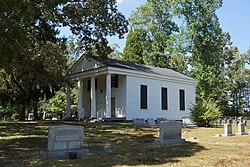Olivet Presbyterian Church | |
 | |
| Location | 2.7 miles (4.3 km) northwest of Providence Forge on VA 618, near Providence Forge, Virginia |
|---|---|
| Coordinates | 37°28′48″N77°3′50″W / 37.48000°N 77.06389°W |
| Area | 1 acre (0.40 ha) |
| Built | 1856 |
| Architectural style | Greek Revival |
| NRHP reference No. | 78003034 [1] |
| VLR No. | 063-0105 |
| Significant dates | |
| Added to NRHP | January 26, 1978 |
| Designated VLR | July 19, 1977 [2] |
Olivet Presbyterian Church is a historic Presbyterian church located near Providence Forge, New Kent County, Virginia. It was built in 1856, and is a small frame church building in the Greek Revival style. It features a flush-boarded, pedimented portico with four fluted Greek Doric order columns. [3]
It was listed on the National Register of Historic Places in 1978. [1]



